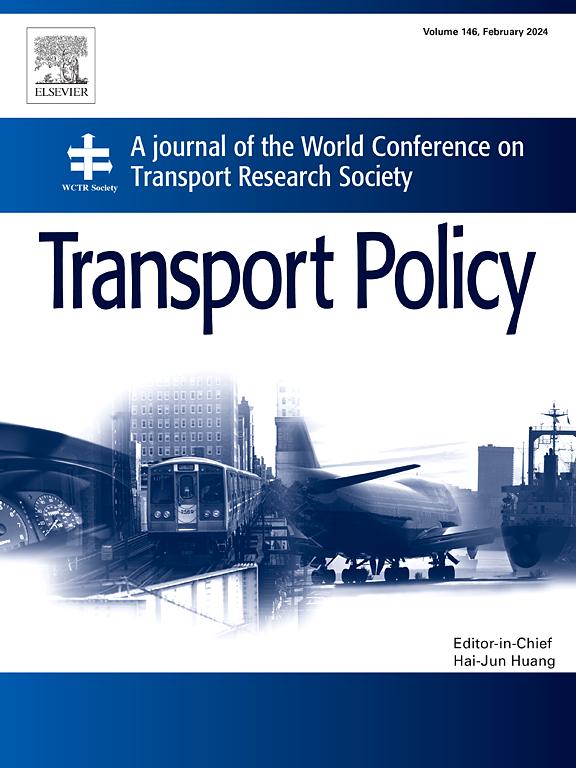求助PDF
{"title":"评估公路网功能层次的方法","authors":"Toshihiro Sekihara , Yuji Kakimoto , Hideki Nakamura , Miho Iryo , Xin Zhang","doi":"10.1016/j.tranpol.2024.06.012","DOIUrl":null,"url":null,"abstract":"<div><p>In Japan, the mobility functions of principal arterial roads are hindered by lined-up roadside facilities and densely located signalized intersections. As one of the solutions, it is necessary to consider a functional hierarchy of road networks, based on the structure and traffic operations of each road. The purpose of this study was to propose an index to evaluate the degree to which the road network could be used hierarchically according to their mobility function, based on the location of the bases and the location of roads at each level of the hierarchy, and to propose a method to evaluate the road network using this index. To accomplish this, we proposed a four-level method for the evaluation of the functional hierarchy of road networks based on the derived index values. As a case study, we calculated the degree of hierarchy for the road networks in northern Mie and western Shizuoka. The results showed that the current evaluations of the functional hierarchy in these regions were low, and that introducing mid-level roads was necessary to improve the current situation. The evaluation method proposed in this study will enable us to examine the ideal network configuration for each road in the region to exhibit its mobility function as a preliminary step to studying solutions to various road network issues, such as ensuring the smooth movement between bases and safety. © 2023 The Authors. Published by Elsevier B.V. This is an open access article under the CC BY-NC-ND license (<span>https://creativecommons.org/licenses/by-nc-nd/4.0</span><svg><path></path></svg>) Peer-review under responsibility of the scientific committee of the World Conference on Transport Research – WCTR 2023.</p></div>","PeriodicalId":48378,"journal":{"name":"Transport Policy","volume":null,"pages":null},"PeriodicalIF":6.3000,"publicationDate":"2024-06-22","publicationTypes":"Journal Article","fieldsOfStudy":null,"isOpenAccess":false,"openAccessPdf":"","citationCount":"0","resultStr":"{\"title\":\"A method for evaluating the functional hierarchy of road networks\",\"authors\":\"Toshihiro Sekihara , Yuji Kakimoto , Hideki Nakamura , Miho Iryo , Xin Zhang\",\"doi\":\"10.1016/j.tranpol.2024.06.012\",\"DOIUrl\":null,\"url\":null,\"abstract\":\"<div><p>In Japan, the mobility functions of principal arterial roads are hindered by lined-up roadside facilities and densely located signalized intersections. As one of the solutions, it is necessary to consider a functional hierarchy of road networks, based on the structure and traffic operations of each road. The purpose of this study was to propose an index to evaluate the degree to which the road network could be used hierarchically according to their mobility function, based on the location of the bases and the location of roads at each level of the hierarchy, and to propose a method to evaluate the road network using this index. To accomplish this, we proposed a four-level method for the evaluation of the functional hierarchy of road networks based on the derived index values. As a case study, we calculated the degree of hierarchy for the road networks in northern Mie and western Shizuoka. The results showed that the current evaluations of the functional hierarchy in these regions were low, and that introducing mid-level roads was necessary to improve the current situation. The evaluation method proposed in this study will enable us to examine the ideal network configuration for each road in the region to exhibit its mobility function as a preliminary step to studying solutions to various road network issues, such as ensuring the smooth movement between bases and safety. © 2023 The Authors. Published by Elsevier B.V. This is an open access article under the CC BY-NC-ND license (<span>https://creativecommons.org/licenses/by-nc-nd/4.0</span><svg><path></path></svg>) Peer-review under responsibility of the scientific committee of the World Conference on Transport Research – WCTR 2023.</p></div>\",\"PeriodicalId\":48378,\"journal\":{\"name\":\"Transport Policy\",\"volume\":null,\"pages\":null},\"PeriodicalIF\":6.3000,\"publicationDate\":\"2024-06-22\",\"publicationTypes\":\"Journal Article\",\"fieldsOfStudy\":null,\"isOpenAccess\":false,\"openAccessPdf\":\"\",\"citationCount\":\"0\",\"resultStr\":null,\"platform\":\"Semanticscholar\",\"paperid\":null,\"PeriodicalName\":\"Transport Policy\",\"FirstCategoryId\":\"5\",\"ListUrlMain\":\"https://www.sciencedirect.com/science/article/pii/S0967070X24001768\",\"RegionNum\":2,\"RegionCategory\":\"工程技术\",\"ArticlePicture\":[],\"TitleCN\":null,\"AbstractTextCN\":null,\"PMCID\":null,\"EPubDate\":\"\",\"PubModel\":\"\",\"JCR\":\"Q1\",\"JCRName\":\"ECONOMICS\",\"Score\":null,\"Total\":0}","platform":"Semanticscholar","paperid":null,"PeriodicalName":"Transport Policy","FirstCategoryId":"5","ListUrlMain":"https://www.sciencedirect.com/science/article/pii/S0967070X24001768","RegionNum":2,"RegionCategory":"工程技术","ArticlePicture":[],"TitleCN":null,"AbstractTextCN":null,"PMCID":null,"EPubDate":"","PubModel":"","JCR":"Q1","JCRName":"ECONOMICS","Score":null,"Total":0}
引用次数: 0
引用
批量引用


